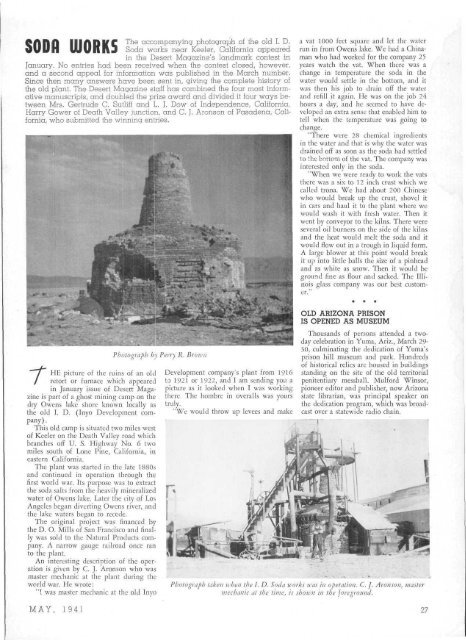M A G A Z •: - Desert Magazine of the Southwest
M A G A Z •: - Desert Magazine of the Southwest
M A G A Z •: - Desert Magazine of the Southwest
You also want an ePaper? Increase the reach of your titles
YUMPU automatically turns print PDFs into web optimized ePapers that Google loves.
soon WORKS<br />
The accompanying photograph <strong>of</strong> <strong>the</strong> old I. D.<br />
Soda works near Keeler, California appeared<br />
in <strong>the</strong> <strong>Desert</strong> <strong>Magazine</strong>'s landmark contest in<br />
January. No entries had been received when <strong>the</strong> contest closed, however,<br />
and a second appeal for information was published in <strong>the</strong> March number.<br />
Since <strong>the</strong>n many answers have been sent in, giving <strong>the</strong> complete history <strong>of</strong><br />
<strong>the</strong> old plant. The <strong>Desert</strong> <strong>Magazine</strong> staff has combined <strong>the</strong> four most informative<br />
manuscripts, and doubled <strong>the</strong> prize award and divided it four ways between<br />
Mrs. Gertrude C. Sutliff and L. J. Dow <strong>of</strong> Independence, California,<br />
Harry Gower <strong>of</strong> Death Valley junction, and C. J. Aronson <strong>of</strong> Pasadena, California,<br />
who submitted <strong>the</strong> winning entries.<br />
rHE picture <strong>of</strong> <strong>the</strong> ruins <strong>of</strong> an old<br />
retort or furnace which appeared<br />
in January issue <strong>of</strong> <strong>Desert</strong> <strong>Magazine</strong><br />
is part <strong>of</strong> a ghost mining camp on <strong>the</strong><br />
dry Owens lake shore known locally as<br />
<strong>the</strong> old I. D. (Inyo Development company).<br />
This old camp is situated two miles west<br />
<strong>of</strong> Keeler on <strong>the</strong> Death Valley road which<br />
branches <strong>of</strong>f U. S. Highway No. 6 two<br />
miles south <strong>of</strong> Lone Pine, California, in<br />
eastern California.<br />
The plant was started in <strong>the</strong> late 1880s<br />
and continued in operation through <strong>the</strong><br />
first world war. Its purpose was to extract<br />
<strong>the</strong> soda salts from <strong>the</strong> heavily mineralized<br />
water <strong>of</strong> Owens lake. Later <strong>the</strong> city <strong>of</strong> Los<br />
Angeles began diverting Owens river, and<br />
<strong>the</strong> lake waters began to recede.<br />
The original project was financed by<br />
<strong>the</strong> D. O. Mills <strong>of</strong> San Francisco and finally<br />
was sold to <strong>the</strong> Natural Products company.<br />
A narrow gauge railroad once ran<br />
to <strong>the</strong> plant.<br />
An interesting description <strong>of</strong> <strong>the</strong> operation<br />
is given by C. J. Aronson who was<br />
master mechanic at <strong>the</strong> plant during <strong>the</strong><br />
world war. He wrote:<br />
"1 was master mechanic at <strong>the</strong> old Inyo<br />
MAY, 1 94 1<br />
Photograph by Perry R. Brown<br />
Development company's plant from 1916<br />
to 1921 or 1922, and I am sending you a<br />
picture as it looked when I was working<br />
<strong>the</strong>re. The hombre in overalls was yours<br />
truly.<br />
"We would throw up levees and make<br />
a vat 1000 feet square and let <strong>the</strong> water<br />
run in from Owens lake. We had a Chinaman<br />
who had worked for <strong>the</strong> company 25<br />
years watch <strong>the</strong> vat. When <strong>the</strong>re was a<br />
change in temperature <strong>the</strong> soda in <strong>the</strong><br />
water would settle in <strong>the</strong> bottom, and it<br />
was <strong>the</strong>n his job to drain <strong>of</strong>f <strong>the</strong> water<br />
and refill it again. He was on <strong>the</strong> job 24<br />
hours a day, and he seemed to have developed<br />
an extra sense that enabled him to<br />
tell when <strong>the</strong> temperature was going to<br />
change.<br />
"There were 28 chemical ingredients<br />
in <strong>the</strong> water and that is why <strong>the</strong> water was<br />
drained <strong>of</strong>f as soon as <strong>the</strong> soda had settled<br />
to <strong>the</strong> bottom <strong>of</strong> <strong>the</strong> vat. The company was<br />
interested only in <strong>the</strong> soda.<br />
"When we were ready to work <strong>the</strong> vats<br />
<strong>the</strong>re was a six to 12 inch crust which we<br />
called trona. We had about 200 Chinese<br />
who would break up <strong>the</strong> crust, shovel it<br />
in cars and haul it to <strong>the</strong> plant where we<br />
would wash it with fresh water. Then it<br />
went by conveyor to <strong>the</strong> kilns. There were<br />
several oil burners on <strong>the</strong> side <strong>of</strong> <strong>the</strong> kilns<br />
and <strong>the</strong> heat would melt <strong>the</strong> soda and it<br />
would flow out in a trough in liquid form.<br />
A large blower at this point would break<br />
it up into little balls <strong>the</strong> size <strong>of</strong> a pinhead<br />
and as white as snow. Then it would be<br />
ground fine as flour and sacked. The Illinois<br />
glass company was our best customer."<br />
OLD ARIZONA PRISON<br />
IS OPENED AS MUSEUM<br />
Thousands <strong>of</strong> persons attended a twoday<br />
celebration in Yuma, Ariz., March 29-<br />
30, culminating <strong>the</strong> dedication <strong>of</strong> Yuma's<br />
prison hill museum and park. Hundreds<br />
<strong>of</strong> historical relics are housed in buildings<br />
standing on <strong>the</strong> site <strong>of</strong> <strong>the</strong> old territorial<br />
penitentiary messhall. Mulford Winsor,<br />
pioneer editor and publisher, now Arizona<br />
state librarian, was principal speaker on<br />
<strong>the</strong> dedication program, which was broadcast<br />
over a statewide radio chain.<br />
I '<br />
Photograph taken when <strong>the</strong> I. D. Soda works ivas in operation. C. J. Aronson, master<br />
mechanic at <strong>the</strong> time, is shoivn in <strong>the</strong> foreground.

















